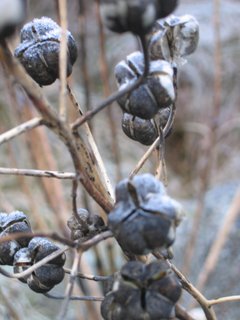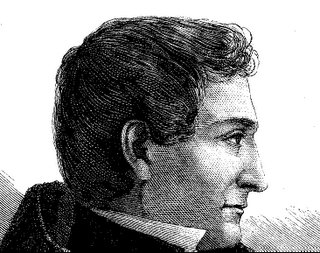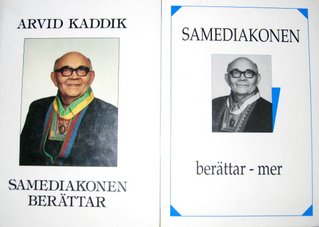Thursday, December 28, 2006
 Petrus Laestadius, Yngve Ryd and Harsh Times in Lapland
Petrus Laestadius, Yngve Ryd and Harsh Times in LaplandPetrus Laestadius tells in his journals about the harsh years in 1828 to 1832 when all bad fortune gathered over Lapland. Most of all, there was hard crust on the snow (called tjocke, tjuocke, or, in Swedish, flen, by Laestadius), preventing reindeer from grazing. “It can be supposed that the Mountain-lapps' reindeer herds in Arjeplog, in this one year (1828), were diminished by at least one third. Rich Lapps became poor, and those who earlier had small reindeer-herds became unable to sustain as Nomads, so that many left for Norway and settled there.”
In the coming years, there were many wolves, preying on the reindeer and scattering them, and much lemmings consuming the alpine forage. There were also forest fires, and summer frost.
In 1832 there was another winter of tjuocke. “Of the Lapps, who actually are my people, the best part, the Forest‑lapps, have been almost totally ruined: their want is incomparable to that of any others. The reindeer-herds of the Mountain-lapps are at least halved: so hard times must have been rarely occurring.”
Tjuocke is actually a problem also in the present winter 2006/2007. In our county 50 000 reindeer may need to be transported by truck to the coast. Even if the effects will be less dramatic nowadays – no people will starve to death – the costs for supplemental feeding will be serious enough.
In the excellent book “Snö” by Yngve Ryd where the Lule Sámi vocabulary on snow is explored, the tjuohke phenomenon is analysed also. It is a crust of ice that entirely locks the lichen forage so grazing is impossible. It forms already in the autumn and does not melt until spring. It is the worst possible winter condition for the reindeer.
 Stig Lindberg - the deck of cards
Stig Lindberg - the deck of cardsI told about the Stig Lindberg-designed deck of cards, that we sometimes played with (in the September 30 entry). It really stands out among card decks for its bold design. There was one deck with blue back side, and one with red. The blue one, which had been retrieved from a poker-playing uncle, I saw again this Christmas day.
Here is just the Joker, which by the way carries the same pattern as the back side - the very typical Lindberg harlequin pattern. The series is called "Comedia" and was released by Öbergs playing card factory in 1958. It was reprinted again later, in the 70's maybe, but does not seem to be available in stores any longer. An unused deck, supposedly the original version, can be bought on the Internet for 650 SEK.
More about Stig Lindberg can be read here .
Sunday, December 17, 2006
 Winter again?
Winter again?Winter came in October and left again in November. Now fínally we are having 5 degrees below zero. The archipelago garden is frosty but not snowy. Dry lily stalks still stand upright carrying their seed capsules like little bells.
The rowans are waiting for the moose to take their yearly toll of top shoots. Waxwings swarm and ring aginst wintery clouds.
Will winter stay? Or is it just another joke?
Saturday, December 16, 2006

Meanwhile, in Norrland….
Two famous travel diaries overlap in 1831-1832. These are Darwin’s travels on board the "Beagle” 1831-1836, and Petrus Laestadius’ mission travels in Norrland 1827-1832. Although the former has a greater fame internationally, also Laestadius is well worth reading. He was born in Arjepluog in 1802 and as a small child he was raised under incredibly miserable conditions.
Much thanks to the efforts of his elder half brother, who was a priest in Kvikkjokk, Petrus came to be educated in theology in Uppsala and came into contact with modern ideas including Kantian philosophy. Laestadius returned to Lapland and became a missionary. His journals are still very readable, and give much more information on local nature and culture than other similar sources, for example Linnaeus’ Laplandic account, since he was of local origin and a fluent Sámi speaker.
Thursday, December 07, 2006
 Valparaíso 2001 again
Valparaíso 2001 againWe got another good advice from Francisco Roca, and this was about what to do in Valparaíso. This was to visit the Nordic School. There is a Swedish folkhögskola (Biskops Arnö) giving a film course for young Swedes, many with a Latin American background, Escuela Nórdica de Cine Documental.
We visited the school together with our friend. This was a very good place, situated high over the town on one of the many hills which are reached by the elevators (ascensores). We saw some student productions, many bringing up difficult subjects such as social injustice and sex among young people in Chile, and talked with the teachers. (I think the students were somewhere else at that time because we didn’t meet them.)
The students live for a year in Valparaiso meeting local young people and interviewing and making film with and about them. In this way they learned a lot about making film, about people, about Valparaíso, Chile and Latin America, and not least, a lot about themselves and their own background.
Picture by Julia Lundberg, student at the school
Tuesday, December 05, 2006
 Crossroads – Arvid Kaddik in Arjepluog
Crossroads – Arvid Kaddik in ArjepluogAn elderly person I know well told the other day about how Arvid Kaddik (see October 18 entry) came to her village every Christmas in the mountain area of Arjeplog parish to give a sermon. Then there was also a reason to have a Christmas party for the whole village.
Kaddik, a deacon, was deeply religious and something of a mystic. He was of Sàmi origin and born in 1904. He first was aducated to be a teacher and then studied theology. He travelled all his life among the Swedish Sàmi people and was loved everywhere for his kindness. He was also important for promoting Sàmi culture – and it was in this role he took part in the meeting in Yttervik, where I got the chance to meet him.
He wrote down his memories in two volumes 1989 and 1992.
Monday, December 04, 2006
 Sour Fish 7 - The Concept
Sour Fish 7 - The ConceptContinuing the series from August, here is a new marketing concept for sour herring from Ulvö Little Saltery under the brand Eric the Red. The idea seems to be that this fish is a viking food with "sybaritic aromas and sublime taste".
The fish can is packed in a box with a nicely designed leaflet in Japanese and several other languages. It is sold together with similarly branded bread and beer from other local producers. Maybe this new branding idea can recruit new sour herring fans?
How it tastes? I didn't open the can yet - as I wait for some special occasion...